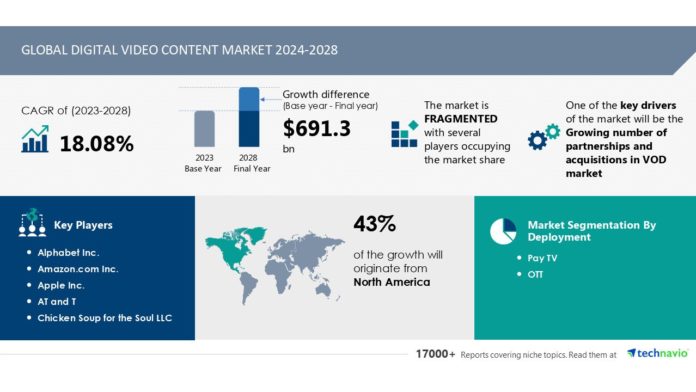Report on how AI is redefining market landscape- The global digital video content market size is estimated to grow by USD 691.3 billion from 2024-2028, according to Technavio. The market is estimated to grow at a CAGR of 18.08% during the forecast period. Growing number of partnerships and acquisitions in vod market is driving market growth, with a trend towards growing number of cross-platform partnerships. However, availability of pirated video content on online platforms poses a challenge. Key market players include Alphabet Inc., Amazon.com Inc., Apple Inc., AT and T, Chicken Soup for the Soul LLC, Comcast Corp., Lions Gate Entertainment Corp., Meta Platforms Inc., Netflix Inc., One Day Video Ltd., Roku Inc., Snap Inc., Sony Group Corp., Stir Fry Content Kitchen, The Walt Disney Co., Twitter Inc., Verizon, Viacom18 Media Pvt. Ltd., Walmart Inc., and Youku Tudou Inc..
The digital video content market is experiencing notable expansion, primarily fueled by Over-The-Top (OTT) service providers. To stay competitive, Pay-TV services are forming collaborations, providing Subscription Video on Demand (SVOD) and Ad-Supported Video on Demand (AVOD) services like Netflix and Amazon Prime Video. These alliances benefit both parties, enabling Pay-TV providers to expand their offerings and retain customers. An example of such a partnership was announced by Verizon in April 2019, allowing their Fios TV clients to subscribe to YouTube TV as part of their IPTV service.
In today’s digital world, the consumption of video content is on the rise. TV shows, movies, music videos, advertisements, and more are increasingly being accessed on digital platforms through tablets, laptops, and smart TVs. The younger population prefers digital media for entertainment purposes, with the expansion of 4G making live streaming videos a reality. Digital video services like Netflix, Amazon Prime, and Hulu are leading the charge, offering personalized content based on user preferences. Social media platforms are also jumping on the bandwagon, with live streaming and promotional videos becoming popular. Businesses use digital video content for B2B communication, e-newsletters, blog posts, and advertising. AI, IT, and cloud computing are essential tools for creating, storing, and distributing text, audio, video, graphics, and photographs. The hotel industry, healthcare and pharmaceutical, media and entertainment, pay TV, and OTT are some industries leveraging digital video content for various purposes. Online traffic is driving the growth of digital video content, with educational content, music, and internet proliferation fueling the demand. Mobile devices and personal computers are the primary devices for accessing digital video content. Voice search is the new trend, making content more accessible than ever before. On-premise and cloud-based solutions cater to different business needs.
The digital video content market faces a significant challenge due to the increasing prevalence of video piracy, particularly through torrenting. Torrents, which are digital files containing metadata, enable users to download unauthorized copyrighted content using software like BitTorrent. This practice is illegal, and the availability of free TV shows, movies, documentaries, and videos through torrents eliminates the need for subscriptions to streaming services. Moreover, the content shared via torrents is typically ad-free, providing an advantage over ad-supported video on demand (AVOD) services. The affordability and convenience of torrenting hinder the growth of the global digital video content market.
In today’s digital world, creating engaging content is essential for businesses looking to connect with their audience. One popular format is digital video content, which includes live streaming videos for promotional purposes. However, creating high-quality video content involves various challenges. IT infrastructure like AI, cloud computing, and graphics are required for production. Text, audio, photographs, and graphics must be integrated to create an engaging video. For B2B communication, personalization marketing, and industries like hotel, healthcare, and media, video content is crucial. Platforms like Pay TV, OTT, and Advertising offer subscription-based services for businesses. Personal computers and mobiles are the primary devices for accessing this content. However, challenges persist, including internet proliferation, piracy of content, and the need for e-newsletters, blog posts, and voice search optimization. On-premise and cloud solutions are available to address these challenges, making digital video content a vital tool for businesses in various sectors.
The Pay-TV market encompasses digital video content delivery methods, primarily divided into subscription-based and on-demand models. The market’s expansion is fueled by the rising popularity of IPTV, an Internet Protocol (IP)-based content delivery system. IPTV offers several advantages, such as easy integration with IP-based services, compatibility with various display devices, and interactive features like electronic program guides (EPGs) and personal video recorders (PVRs). These advantages have led to its increasing adoption, particularly in emerging markets where satellite TV is replacing traditional cable connections. The shift is due to reduced network infrastructure costs and government regulations promoting satellite TV. IPTV’s growth is also driven by the expanding Internet penetration and digital literacy, making it an attractive alternative to cable TV. Overall, these factors contribute to the significant growth of the Pay-TV market, with IPTV subscriptions on the rise.
The Digital Video Content Market is a dynamic and ever-evolving industry that encompasses various forms of multimedia content, including TV shows, movies, music videos, advertisements, and more. This market thrives on digital platforms, making it accessible to consumers on tablets, laptops, smart TVs, and personal computers. The younger population is a significant demographic, with a strong preference for on-demand and personalized content. Content creation involves the use of Text, Audio, Video, Graphics, Photographs, and even AI, IT, and Cloud computing. Digital content includes TV shows and movies available on Pay TV and Over-The-Top (OTT) platforms, educational content, music, and various forms of advertising. The market is vast and diverse, catering to various industries and niches, from entertainment to education and business. The Digital Video Content Market is a growing industry, with new technologies and trends emerging regularly. Subscription-based models, mobile devices, and the integration of AI and machine learning algorithms are some of the latest developments shaping the market. The future of digital video content is exciting, with endless possibilities for creativity, innovation, and engagement.
Digital video content market is experiencing exponential growth, fueled by the increasing popularity of TV shows, movies, music videos, advertisements, and digital platforms. Younger populations are leading the charge, consuming content on tablets, laptops, and smart TVs. The expansion of 4G and the rise of cable TV alternatives like digital video services have disrupted traditional entertainment industries. Social media platforms and live streaming videos have become essential tools for promotional purposes. Text, audio, video, graphics, photographs, AI, IT, and cloud computing are key components of digital video content creation. The healthcare and pharmaceutical, media and entertainment, pay TV, Over-The-Top (OTT), advertising, subscription, and educational content industries are major consumers. Personalization marketing, voice search, and B2B communication are emerging trends. Online traffic from personal computers and mobiles is driving demand for high-quality content. However, the challenge of internet proliferation and piracy of content remains a significant concern.







